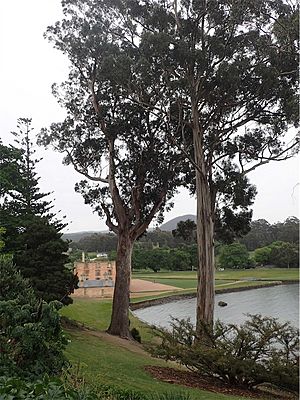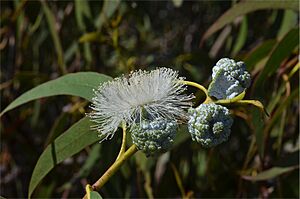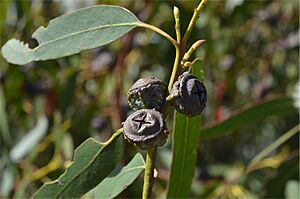Tasmanian blue gum facts for kids
Quick facts for kids Tasmanian blue gum |
|
|---|---|
 |
|
| E. globulus globulus at Port Arthur | |
| Scientific classification |
|
| Kingdom: | Plantae |
| Clade: | Tracheophytes |
| Clade: | Angiosperms |
| Clade: | Eudicots |
| Clade: | Rosids |
| Order: | Myrtales |
| Family: | Myrtaceae |
| Genus: | Eucalyptus |
| Species: | |
| Subspecies: |
E. g. subsp. globulus
|
| Trinomial name | |
| Eucalyptus globulus subsp. globulus |
|
| Synonyms | |
|
Eucalyptus globulus Labill. var. globulus |
|
The Tasmanian blue gum, also called southern blue gum or just blue gum, is a special type of tree. Its scientific name is Eucalyptus globulus subsp. globulus. This tree only grows naturally in southeastern Australia. When a plant or animal is found only in one place, it is called endemic.
This amazing tree has bark that is mostly smooth. Sometimes, you might see old pieces of bark still attached near the bottom. Its young leaves have one side that looks a bit powdery white or blue-green, which is called glaucous. The adult leaves are shiny and shaped like a spear.
The Tasmanian blue gum also has bumpy flower buds. These buds grow one by one where a leaf meets the stem, which is called a leaf axil. When the flowers open, they are white. After flowering, the tree produces fruit that looks like a woody cap. It is shaped like half a sphere or a cone and is usually square when you look at it from the side.
Contents
What Does the Tasmanian Blue Gum Look Like?
The Tasmanian blue gum is a very tall tree. It can grow up to 70 m (230 ft) high, which is like a 23-story building! It also has a special woody swelling at its base called a lignotuber. This helps the tree regrow if it gets damaged.
Bark and Stems
The bark on most of the tree is smooth. It peels off in long strips, leaving behind a white or grey surface. Sometimes, you might see rough, partly peeled bark near the bottom of the trunk. Long ribbons of bark can also hang from the upper branches. Young trees and new shoots that grow after the tree is cut down have stems that are almost square. Each corner of these stems has a clear ridge or "wing."
Leaves of the Blue Gum Tree
The young leaves of the Tasmanian blue gum are directly attached to the stem, meaning they are sessile. They grow in pairs, one across from the other. These leaves are oval or egg-shaped. Their underside is covered in a white, waxy layer. They can be 40–105 mm (1.6–4.1 in) long and 22–50 mm (0.87–1.97 in) wide.
As the tree gets older, its leaves change. Adult leaves grow one after another along the stem, not in pairs. They are shiny green and shaped like a spear or slightly curved. These leaves are much longer, from 120–300 mm (4.7–11.8 in) long, and about 17–30 mm (0.67–1.18 in) wide. Each adult leaf has a stem called a petiole that is 20–35 mm (0.79–1.38 in) long.
Flowers and Fruit
The flower buds of the Tasmanian blue gum grow one by one in the leaf axils. They are on a thick stalk called a peduncle, which can be up to 5 mm (0.20 in) long or sometimes directly attached. When the buds are ready, they look powdery white or blue-green and are cone-shaped with a bumpy surface. They are quite large, about 14–25 mm (0.55–0.98 in) long and 14–20 mm (0.55–0.79 in) wide. They have four ridges along their sides and a flat top with a small knob in the middle.
The Tasmanian blue gum flowers between May and January. Its flowers are white. After the flowers, the tree produces a woody fruit. This fruit is a capsule that is directly attached to the branch. It is shaped like half a sphere or a cone and is square when you look at it from the side. The fruit is about 10–15 mm (0.39–0.59 in) long and 14–27 mm (0.55–1.06 in) wide. It also has four ridges along its length, and the parts that open to release seeds are usually level with the rim.
Where Does the Tasmanian Blue Gum Grow?
This blue gum tree grows in forests and woodlands. It prefers moist valleys in the Australian states of Victoria and Tasmania. You can find it on islands like Flinders and King Islands too. It is very common in the lower areas of Tasmania. In Victoria, it is only found in the very south, in places like Port Franklin and Wilsons Promontory.
How Was the Tasmanian Blue Gum Named?
The Tasmanian blue gum was first officially described in the year 1800. A French botanist named Jacques Labillardière wrote about it in his book, Relation du Voyage à la Recherche de la Pérouse. Later, in 1974, another scientist named James Barrie Kirkpatrick identified four different types, or subspecies, of E. globulus. The E. globulus subsp. globulus became the main, original name for this specific type of blue gum.



